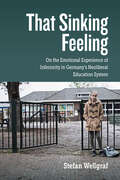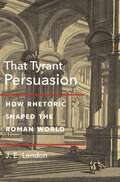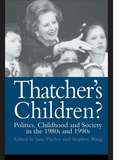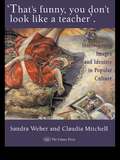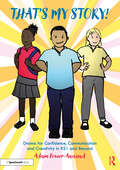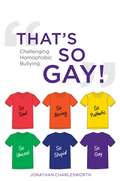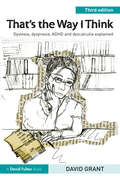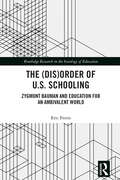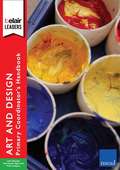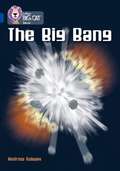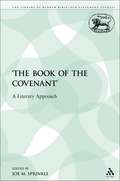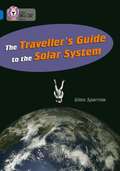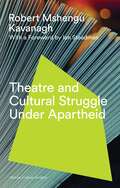- Table View
- List View
That Sinking Feeling: On the Emotional Experience of Inferiority in Germany's Neoliberal Education System
by Stefan WellgrafEmotions, especially those of impoverished migrant families, have long been underrepresented in German social and cultural studies. That Sinking Feeling raises the visibility of the emotional dimensions of exclusion processes and locates students in current social transformations. Drawing from a year of ethnographic fieldwork with grade ten students, Stefan Wellgraf’s study on an array of both classic emotions and affectively charged phenomena reveals a culture of devaluation and self-assertion of the youthful, post-migrant urban underclass in neoliberal times.
That Tyrant, Persuasion: How Rhetoric Shaped the Roman World
by J. E. LendonHow rhetorical training influenced deeds as well as words in the Roman EmpireThe assassins of Julius Caesar cried out that they had killed a tyrant, and days later their colleagues in the Senate proposed rewards for this act of tyrannicide. The killers and their supporters spoke as if they were following a well-known script. They were. Their education was chiefly in rhetoric and as boys they would all have heard and given speeches on a ubiquitous set of themes—including one asserting that &“he who kills a tyrant shall receive a reward from the city.&” In That Tyrant, Persuasion, J. E. Lendon explores how rhetorical education in the Roman world influenced not only the words of literature but also momentous deeds: the killing of Julius Caesar, what civic buildings and monuments were built, what laws were made, and, ultimately, how the empire itself should be run.Presenting a new account of Roman rhetorical education and its surprising practical consequences, That Tyrant, Persuasion shows how rhetoric created a grandiose imaginary world for the Roman ruling elite—and how they struggled to force the real world to conform to it. Without rhetorical education, the Roman world would have been unimaginably different.
Thatcher's Children?: Politics, Childhood And Society In The 1980s And 1990s
by Dr Jane Pilcher Jane Pilcher Stephen WaggThat childhood is a social construction is understood both by social scientists and in society generally. The authors of this book examine the political issues surrounding childhood, including law making, social policy, government provisions and political activism.; This text examines current social and political issues involving childhood. It looks at the impact of the "New Right" who talk of family values, parent power in schools, irresponsible provision of contraception to young girls and the increase in child violence as a result of mass media. It also considers the response of the caring professions and the "Modern Left" who campaign, amongst other things, for the establishment of children's rights.
Thatcher's Children?: Politics, Childhood And Society In The 1980s And 1990s (The\world Of Childhood And Adolescence Ser. #No. 6)
by Dr Jane Pilcher Jane Pilcher Stephen WaggThat childhood is a social construction is understood both by social scientists and in society generally. The authors of this book examine the political issues surrounding childhood, including law making, social policy, government provisions and political activism.; This text examines current social and political issues involving childhood. It looks at the impact of the "New Right" who talk of family values, parent power in schools, irresponsible provision of contraception to young girls and the increase in child violence as a result of mass media. It also considers the response of the caring professions and the "Modern Left" who campaign, amongst other things, for the establishment of children's rights.
That's Funny You Don't Look Like A Teacher!: Interrogating Images, Identity, And Popular Culture
by Sandra J Weber Claudia MitchellWhat do you see when you think of teacher? Where does what you see come from? This is a book about the images of teachers and teaching which permeate the everyday lives of children and adults, shaping in important but unrecognised ways their notions of whom teachers are and what they do. The authors show how, using a creative interdisciplinary approach, it is possible to analyse drawings of teachers, television programmes, films, cartooons, comics and even Barbie dolls. Illustrated with colour reproductions and excerpts from interviews and journals, this book should appeal to teachers, academics and anyone who is interested in the popular culture of childhood, gender issues, professional identity and teacher education.
That's Funny You Don't Look Like A Teacher!: Interrogating Images, Identity, And Popular Culture
by Sandra J Weber Claudia MitchellWhat do you see when you think of teacher? Where does what you see come from? This is a book about the images of teachers and teaching which permeate the everyday lives of children and adults, shaping in important but unrecognised ways their notions of whom teachers are and what they do. The authors show how, using a creative interdisciplinary approach, it is possible to analyse drawings of teachers, television programmes, films, cartooons, comics and even Barbie dolls. Illustrated with colour reproductions and excerpts from interviews and journals, this book should appeal to teachers, academics and anyone who is interested in the popular culture of childhood, gender issues, professional identity and teacher education.
That's My Story!: Drama for Confidence, Communication and Creativity in KS1 and Beyond
by Adam Power-AnnandThe ability to communicate is an essential life skill for all children and young people and it underpins their social, emotional and educational development. If a child experiences a positive relationship with an adult listening carefully, they are more likely to constructively share their thoughts, feelings and their imaginative ideas.That’s My Story! places children’s imagined stories at the heart of their own development and provides a joyful, creative approach to support young children’s personal and social development and to encourage their communication. In this book you will find: Tried-and-tested drama games and activities that support communication and well-being, all adaptable to complement your current practice Guidance and advice on how to promote positive adult-child interactions Examples of creative interventions that support children’s communication development A celebration of the joy that comes with carefully listening to children’s own imagined stories Those of us who work with children can sense a tangible connection between how young children feel and how they communicate. This essential and practical resource will be valuable reading for primary teachers, teaching assistants, speech and language therapists, and drama practitioners, as well as outreach and education departments of theatre companies and other arts organisations.
That's My Story!: Drama for Confidence, Communication and Creativity in KS1 and Beyond
by Adam Power-AnnandThe ability to communicate is an essential life skill for all children and young people and it underpins their social, emotional and educational development. If a child experiences a positive relationship with an adult listening carefully, they are more likely to constructively share their thoughts, feelings and their imaginative ideas.That’s My Story! places children’s imagined stories at the heart of their own development and provides a joyful, creative approach to support young children’s personal and social development and to encourage their communication. In this book you will find: Tried-and-tested drama games and activities that support communication and well-being, all adaptable to complement your current practice Guidance and advice on how to promote positive adult-child interactions Examples of creative interventions that support children’s communication development A celebration of the joy that comes with carefully listening to children’s own imagined stories Those of us who work with children can sense a tangible connection between how young children feel and how they communicate. This essential and practical resource will be valuable reading for primary teachers, teaching assistants, speech and language therapists, and drama practitioners, as well as outreach and education departments of theatre companies and other arts organisations.
That's Not My Name!
by Anoosha SyedAn uplifting picture book about loving your name, finding your voice and standing up for yourself.Mirha is so excited for her first day of school! She can't wait to learn, play and make new friends. But when her classmates keep mispronouncing her name, she goes home wondering if she should find a new one.When Mama helps Mirha see just how special her name is, she returns to school the next day determined to help her classmates say it correctly. Featuring beautiful, vibrant illustrations and with an empowering message at its core, this heartwarming picture book from author-illustrator Anoosha Syed reminds us all just how important our names are!
That's So Gay!: Challenging Homophobic Bullying
by Jonathan CharlesworthIs there a need to challenge homophobic name-calling and other homophobic bullying in your school but uncertainty about how to address it? That's So Gay! is a practical guide to making your school a safer place and creating an inclusive bully-free culture. It shows what homophobic bullying looks like, who experiences it and explores the reasons why young people bully others homophobically. It also reveals why young people are often reluctant to report homophobic bullying, the increasing role played by the internet and the profound effects bullying can have well into adulthood. Adopting a whole-school approach, this book provides all the advice schools need on prevention, working with those who bully, handling disclosures and anti-bullying policies. Written by an expert in the field, this is a vital guide for schools, teachers and anyone with a duty of care towards young people.
That's So Gay!: Challenging Homophobic Bullying (PDF)
by Jonathan CharlesworthIs there a need to challenge homophobic name-calling and other homophobic bullying in your school but uncertainty about how to address it? That's So Gay! is a practical guide to making your school a safer place and creating an inclusive bully-free culture. It shows what homophobic bullying looks like, who experiences it and explores the reasons why young people bully others homophobically. It also reveals why young people are often reluctant to report homophobic bullying, the increasing role played by the internet and the profound effects bullying can have well into adulthood. Adopting a whole-school approach, this book provides all the advice schools need on prevention, working with those who bully, handling disclosures and anti-bullying policies. Written by an expert in the field, this is a vital guide for schools, teachers and anyone with a duty of care towards young people.
That's the Way I Think: Dyslexia, dyspraxia, ADHD and dyscalculia explained
by David GrantAbout 1 in 20 individuals are dyslexic. This figure also applies for dyspraxia and ADHD. This fully revised edition of David Grant’s thought-provoking, insightful book develops our understanding of these specific learning differences and considers the further challenges presented by these overlapping conditions. This new edition includes a brand-new chapter on dyscalculia. New sections also explore updates in the study of dyslexia, dyspraxia and ADHD as well as visualisation and synaesthesia, in the light of new data and research. These updates enable the reader to gain a fuller understanding of the sensory experiences and thoughts of individuals with specific learning differences. The author takes a life-style approach to explain many of the everyday experiences and choices of individuals with specific learning differences, including sleep, sports, visualisation and creativity, and uses real life examples explained in the words of those with specific learning differences. The accessible style of this book will immediately strike a chord with anyone with first or second-hand experience of specific learning differences. It is invaluable and insightful reading for those with specific learning differences as well as their parents and/or partner, teachers, teaching assistants and SENCos.
That's the Way I Think: Dyslexia, dyspraxia, ADHD and dyscalculia explained
by David GrantAbout 1 in 20 individuals are dyslexic. This figure also applies for dyspraxia and ADHD. This fully revised edition of David Grant’s thought-provoking, insightful book develops our understanding of these specific learning differences and considers the further challenges presented by these overlapping conditions. This new edition includes a brand-new chapter on dyscalculia. New sections also explore updates in the study of dyslexia, dyspraxia and ADHD as well as visualisation and synaesthesia, in the light of new data and research. These updates enable the reader to gain a fuller understanding of the sensory experiences and thoughts of individuals with specific learning differences. The author takes a life-style approach to explain many of the everyday experiences and choices of individuals with specific learning differences, including sleep, sports, visualisation and creativity, and uses real life examples explained in the words of those with specific learning differences. The accessible style of this book will immediately strike a chord with anyone with first or second-hand experience of specific learning differences. It is invaluable and insightful reading for those with specific learning differences as well as their parents and/or partner, teachers, teaching assistants and SENCos.
The: Zygmunt Bauman and Education for an Ambivalent World (Routledge Research in the Sociology of Education)
by Eric FerrisThis book critically interrogates the function of schooling in the United States of America using the writings of sociologist Zygmunt Bauman. Asking whether the function is to produce citizens, workers, a combination of the two, or something altogether different, it argues that the designs of schooling are part of a carefully crafted ordering, illustrated via an analysis of the ways in which schooling introduces students to various forms of coercion and seduction that socialize students in particular ways: ways that support an order. By engaging with the prolific and insightful works of one of the most prominent social thinkers of the 21st century, this book considers schooling and its contributions to order. Be they solid or liquid modern ordering mechanisms, ordering through repression and seduction, or supporting ordering through the creation of boundaries separating an “orderly inside” from its “disorderly outside”; schools imperfectly support the construction of order and in doing so, privilege some representations and individuals over others. To order is to harness ambivalence and steer it in directions that privilege the “in” group at the expense of the “out” group; and schools, from the curriculum they teach to the values and ideas they promote, are desirable captive marketplaces instrumental in steering this ambivalence. The author ultimately suggests that the function of schools, whether recognized or not, are not so much to educate students to be free thinkers, but rather to be orderly cogs in a particular functional social machine. As such, it will be of interest to faculty, scholars and postgraduate-level students with interests in the sociology of education, schooling, sociology, and social theory.
The: Zygmunt Bauman and Education for an Ambivalent World (Routledge Research in the Sociology of Education)
by Eric FerrisThis book critically interrogates the function of schooling in the United States of America using the writings of sociologist Zygmunt Bauman. Asking whether the function is to produce citizens, workers, a combination of the two, or something altogether different, it argues that the designs of schooling are part of a carefully crafted ordering, illustrated via an analysis of the ways in which schooling introduces students to various forms of coercion and seduction that socialize students in particular ways: ways that support an order. By engaging with the prolific and insightful works of one of the most prominent social thinkers of the 21st century, this book considers schooling and its contributions to order. Be they solid or liquid modern ordering mechanisms, ordering through repression and seduction, or supporting ordering through the creation of boundaries separating an “orderly inside” from its “disorderly outside”; schools imperfectly support the construction of order and in doing so, privilege some representations and individuals over others. To order is to harness ambivalence and steer it in directions that privilege the “in” group at the expense of the “out” group; and schools, from the curriculum they teach to the values and ideas they promote, are desirable captive marketplaces instrumental in steering this ambivalence. The author ultimately suggests that the function of schools, whether recognized or not, are not so much to educate students to be free thinkers, but rather to be orderly cogs in a particular functional social machine. As such, it will be of interest to faculty, scholars and postgraduate-level students with interests in the sociology of education, schooling, sociology, and social theory.
THE ART AND DESIGN PRIMARY COORDINATOR’S HANDBOOK (Belair: Leaders Series (PDF))
by John Bowden National Society For Education In Art Design Staff Peter Gregory Susan OgierThe Art and Design Handbook provides you with reliable guidance from The National Society for Education in Art and Design on leading art and design in your school, including the responsibilities of the role, how to assess your school’s performance, how to plan projects and record progress and how to use art in a cross-curricular capacity. The Art and Design Handbook provides you with reliable guidance from The National Society for Education in Art and Design (NSEAD) on leading art and design in your school. Part 1 covers the role and responsibilities of a leader of art and design, how to assess your school’s performance, how to plan projects and record progress and how to use art in a cross-curricular capacity. Part 2 provides practical guidance making full use of key elements of art and design, including: • The language of art • Learning from art and artists • Technology and new media • Drawing • Painting • Printmaking • Textiles and crafts • Clay modelling • 3D construction • Design and designing Staff development activities throughout provide opportunities to further inspire your staff and build on their existing skill set.
THE BIG ASK
by Simon James Green Cover design by Ali Ardington Illustrated by Mallory HeyerAlfie Parker has bagged the hottest date to prom … hasn't he? Bestselling LGBTQ+ writer Simon James Green makes his Barrington Stoke debut with a life-affirming teen romance. Harvey is popular, cool, plays football and has been in a relationship with his girlfriend Summer for as long as anyone can remember. Alfie is not popular, not cool, has a sick note so he doesn't have to play any sport, and has been in a relationship with his Xbox since forever. So when Summer dramatically dumps Harvey just a few days before the school prom, no one is expecting Alfie to ask Harvey to be his date. Least of all Alfie. But sometimes amazing things can happen when you take a chance …
THE BIG BANG: Band 16/Sapphire (Collins Big Cat Ser. (PDF))
by Steve Alton Andrew Solway Collins Big Cat StaffWhat was the Big Bang? What was the Universe like just after the Big Bang? Who discovered the Big Bang? Stunning photographs and detailed information help to explain the answers to these and many other questions in this fascinating non-fiction information book about the Big Bang theory written by award-winning author, Andrew Solway. Sapphire/Band 16 books offer longer reads to develop children's sustained engagement with texts and are more complex syntactically. Text type: A non-fiction book This book has been quizzed for Accelerated Reader.
The 'The Book of the Covenant': A Literary Approach (The Library of Hebrew Bible/Old Testament Studies)
by Joe M. SprinkleThis volume offers a synchronic, literary reading of the final form of the laws of Exodus 20.22-23.19 (commonly, though inaccurately labelled "The Book of the Covenant"), in contrast with primarily source- and form-critical approaches commonly utilized in the past. The work seeks to demonstrate that this literary unit is much more coherent, more integrated into its narrative context, less in need of the positing of corruptions, secondary insertions, rearrangements or the like than has usually been recognized. The approach instead seeks to find authorial purpose in each case where scholars have often posited scribal misadventure, "seams" between sources, disorder, contradiction, or corruption.
THE DAY OF THE JACKDAW
by Jo Simmons Illustrated by Lee CosgroveVillage newcomer Alex must vanquish a vicious feathered foe to finally feel at home in this madcap caper from comedy genius and bestselling author Jo Simmons. Alex is not happy that his family are moving to the village of Noggings. He's even less happy when he discovers that Noggings is under siege from Graham, a vicious jackdaw that has been terrorising the locals, dive-bombing kids in the school playground and targeting dog walkers and picnickers. As he tries to settle in to his new home, can Alex find a way to dodge the flapping fiend and learn what's really behind these angry avian attacks?
THE LIST
by Keith Gray Cover design by Tom Clohosy ColeCan friendships survive as Denny relives the good times and rewrites the bad? A comic and compelling tale from award-winning author Keith Gray. It's the end of the summer and Denny is having to move away with his mum now that she's found a good job, but he's not planning on leaving quietly. He's made a list of scores to settle and wrongs to right before he goes. He asks his best friend, Jake, to help. Jake is absolutely gutted that Denny is leaving and worries what life will be like without him. Of course he'll do anything to help, no matter how weird or unrealistic the items on Denny's list might be. But the list is more powerful than either of them realise - it can make and break friendships.
THE RIVER SPIRIT
by Lucy Strange Illustrated by Julia MoscardoTrapped within the oppresive warrens of the city's chimneys, young sweeper Tom longs for fresh air and freedom in this atmospheric and ghostly tale from Lucy Strange. Young chimney sweep Tom has started seeing strange, supernatural things - fairies in the flowers by the river, a soot monster crouching in the darkness of a chimney, and then the mysterious river spirit Elle. Elle joins Tom and the other children apprenticed to cruel master sweep Mister Crow. Together, they shimmy up the town's narrow, filthy chimneys. But Tom has an ominous feeling in his bones, and when he faces his most dangerous job of all, the reason for Elle's magical appearance becomes clear . . .
THE TRAVELLER’S GUIDE TO THE SOLAR SYSTEM: Band 16/Sapphire (Collins Big Cat Ser. (PDF))
by Giles Sparrow Collins Big Cat StaffBored of spending all your holidays on Mars? Now you can travel further off the beaten astral plane with this fact-packed guide. Sapphire/Band 16 books offer longer reads to develop children's sustained engagement with texts and are more complex syntactically. A travel guide to all the planets in the solar system on pages 54 and 55 makes it easy for children to recap what the key facts they've learnt. Text type: A non-chronological report. Curriculum links: Science; Geography; Citizenship. This book has been quizzed for Accelerated Reader
Theatre and Cultural Struggle under Apartheid (African Culture Archive)
by Robert Mshengu KavanaghIn this book, South African performer and activist Robert Mshengu Kavanagh reveals the complex and conflicting interplay of class, nation and race in South African theatre under Apartheid. Evoking an era when theatre itself became a political battleground, Kavanagh displays how the struggle against Apartheid was played out on the stage as well as on the streets.Kavanagh's account spans three very different areas of South African theatre, with the author considering the merits and limitations of the multi-racial theatre projects created by white liberals; the popular commercial musicals staged for black audiences by emergent black entrepreneurs; and the efforts of the Black Consciousness Movement to forge a distinctly African form of revolutionary theatre in the 1970s.The result is a highly readable, pioneering study of the theatre at a time of unprecedented upheaval, diversity and innovation, with Kavanagh's cogent analysis demonstrating the subtle ways in which culture and the arts can become an effective means of challenging oppression.
Theatre and Cultural Struggle under Apartheid (African Culture Archive)
by Robert Mshengu KavanaghIn this book, South African performer and activist Robert Mshengu Kavanagh reveals the complex and conflicting interplay of class, nation and race in South African theatre under Apartheid. Evoking an era when theatre itself became a political battleground, Kavanagh displays how the struggle against Apartheid was played out on the stage as well as on the streets.Kavanagh's account spans three very different areas of South African theatre, with the author considering the merits and limitations of the multi-racial theatre projects created by white liberals; the popular commercial musicals staged for black audiences by emergent black entrepreneurs; and the efforts of the Black Consciousness Movement to forge a distinctly African form of revolutionary theatre in the 1970s.The result is a highly readable, pioneering study of the theatre at a time of unprecedented upheaval, diversity and innovation, with Kavanagh's cogent analysis demonstrating the subtle ways in which culture and the arts can become an effective means of challenging oppression.
